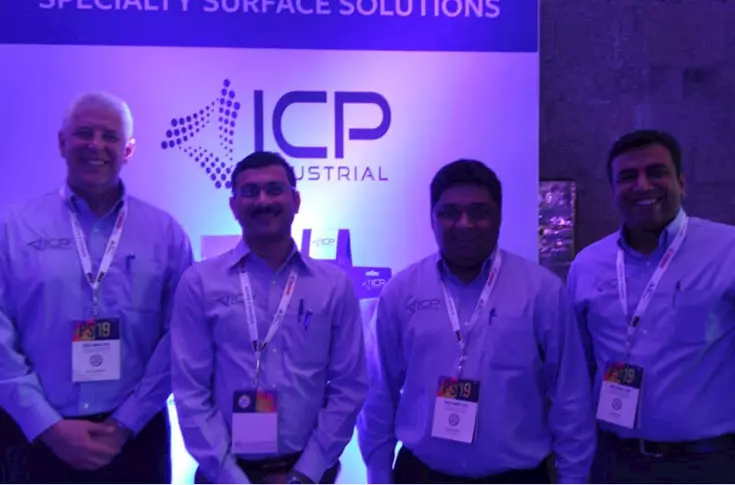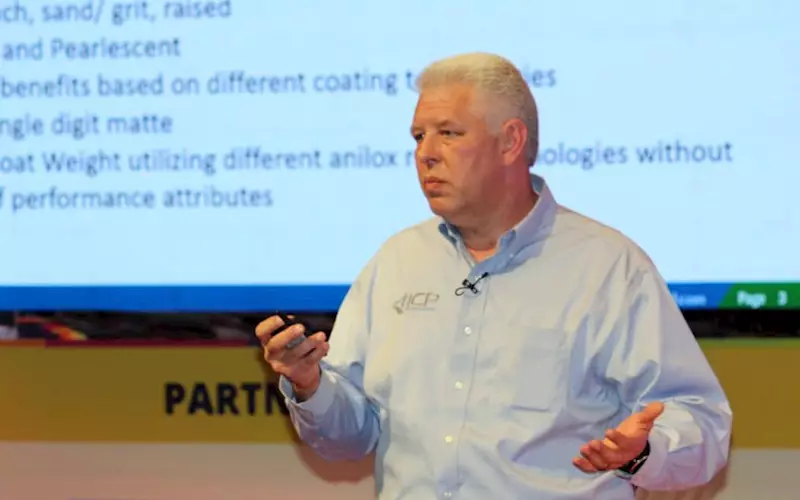Print Summit 2019: Think creatively with coatings, says Don Newberry
Don Newberry, senior marketing manager at ICP Industrial, spoke about glossier margins — innovations in packaging through coatings. At the outset, he mentioned the various techniques which are prevalent today. These are: strike through smooth contrast; drip off effect (contrast and tactile); movement effects; glitters and pearlescent; tactile / haptic and finally, soft touch, sand/ grit, raised. Other than highlighting the special features, one tip he shared with the audience was: operators can guarantee a reduction of coat weight by utilising different anilox roller technologies without compromise of performance attributes.
24 Jan 2019 | By Sujith Ail
Next he shared the highlights about coatings and varnish formulations. He mentioned how in gravure printing technology (direct and offset gravure), volatile organic solvents, such as alcohol, ester, ketone, and toluene, are used. This solvent provides good print quality at a low cost, but on the other hand, affects the environment and human health — high emission of volatile organic compounds (VOCs).
Next he focussed on electron beam coatings which are predominately used in flexo and wide web applications. EB coatings are formulated with oligomers, monomers, and additives (no photo-initiators) for specific performance requirements (gloss, COF, slide angle, product resistance and FDA compliance) based upon application weight, speed and curing equipment. He demystified the curing process of electron beam by stating how it follows the same coating/printing method as UV coatings (flexo or gravure).
Don Newberry said, “The coated substrate passes through the nitrogen blanketed electron beam unit (can vary speed of electrons (kilovolts – penetration depth) and amount of electrons (Megarads – how much crosslinking), depending on coating thickness and curing requirements). After which electrons open double bonds, initiating polymerisation. And then, the free radicals react with double bonds in monomers/oligomers and cause polymerisation."
Newberry said the polymerised components result in formation of a solid coating film on applied substrate.
Next he focussed on UV, HUV, LED, wherein radiation-cured coating technology provides instant curing after application. Energy cured products are used in multiple application processes, including offset (ink train, roll coater and anilox), flexo, gravure, screen and offline coaters. He explained the difference between UV, HUV and LED, which is based on how photo-initiators that react to different nanometer wavelengths and UV spectrum wavelengths.
Newberry dwelt on anilox rollers and photopolymer plates. He said this method is used to provide a measured amount of ink or coating to a blanket or flexo printing plate. An anilox roll is a hard cylinder, usually constructed of steel or aluminium core which is coated with an industrial ceramic, then laser engraved producing millions of very fine dimples, known as cells. He requested members in the audience to bear the following principles while selecting an anilox roller. These are: coating type and viscosity; application speed; desired coat weight and finally, desired effect (textures/ tactile).
The effects which are achievable are:
Strike through smooth contrast (conventional (oil base) litho duct varnish with overall UV coating; contrast gloss/ dull separation – 60+ points; and aqueous formulations available (contrast separation much less than UV)
Drip off effect (UV litho duct varnish with overall UV Coating; control of contrast and tactile feature by application weight of coating (anilox volume) and UV curing; control of pattern (consistent or random) using different duct varnish/ coating combinations
Plus, there are movement effects which utilizes same materials as drip off and vector-based art that creates light diffraction based on viewing angle.
Then he mentioned material variations. For instance: smooth strikethrough which is attained through conventional / UV chemistry used in combination with UV inks and conventional / aqueous chemistry used in combination with oil-based inks. Plus he touched upon drip off - UV / UV and fianlly, movement effect which is rendered with UV / UV.
Finally, he touched upon various effects which are possible with special coatings like haptic, glitter and pearlescent and finally, metallics. The main theme of the presentation was how the Indian graphic industry can leverage ICP Industrial's high-performance portfolio of aqueous, UV/LED/EB, silicone and specialty coatings and adhesive technologies.

Don Newberry has a 34-year background in the graphic arts industry focusing on offset and digital printing. Throughout his career, Newberry has held positions as operations in-charge for multiple printing and packaging firms. His production background included implementing new press and printing technologies while increasing production efficiencies.
Also, he worked with Komori America Corporation for 16 years holding positions in management for demonstration, training, product and business development. In 2014, an opportunity to further focus on specialised coatings emerged. As a result Newberry joined MinusNine Technologies as marketing manager which was taken over by ICP Industrial which is a leader in specialty coatings with brands like Nicoat and MinusNine.











 See All
See All